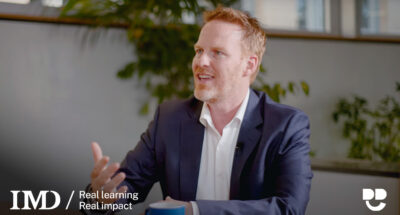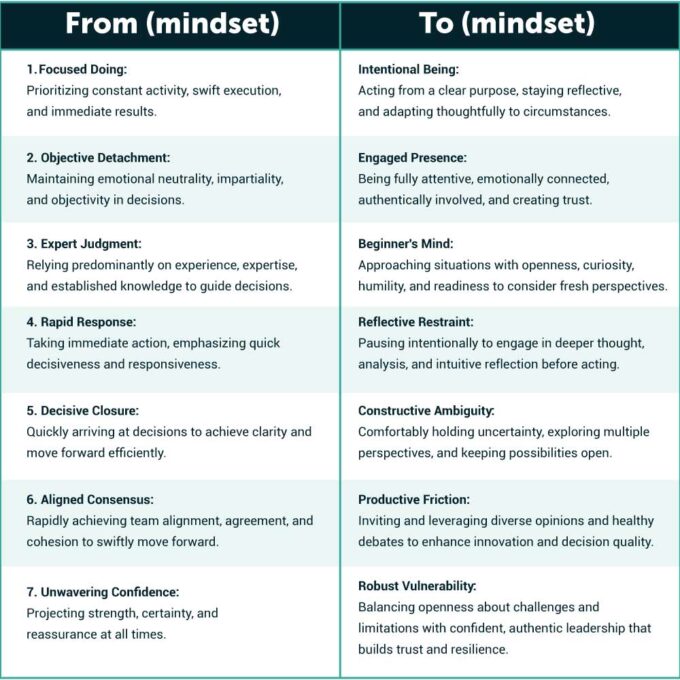
How does sustainable leadership work?
This episode takes you behind the scenes of a recent gathering led by the World Business Council for Sustainable Development together with IMD, where David Bach sat down with two sustainability leaders....

by Michael D. Watkins Published April 11, 2025 in Leadership • 16 min read
Hannah is the CEO of a struggling UK-based sustainable clothing company. Revenues have been squeezed in the last year, and she’s facing some hard choices – among them, whether to relocate to another region in Europe. Response to this is mixed. Half of her team welcomes the move as an opportunity to reduce overheads, while the others believe it’s at odds with the ethos of the business. James can well understand Hannah’s dilemma. He’s VP of operations with a large manufacturing organization headquartered in France. Sluggish performance has led to the closure of a local plant with the loss of 200 jobs. Employees at James’s companies have responded with great hostility. Meanwhile, CTO Michael has miscalculated resource allocation for the launch of his fintech startup’s new payment platform. He has presented a detailed recovery plan to the board, but reactions are mixed and confidence in Michael’s leadership has taken a hit.
Business leaders today are grappling with intensifying competition, accelerating change, increasing complexity, and heightened expectations. In this turbulent and uncertain climate, it can be all too easy to freeze; to experience the kind of decision paralysis that comes from being caught between the pressure for decisive action, and the realization that familiar solutions no longer feel as fit for purpose.
Navigating the complexity facing you and your leadership today calls, I believe, for new approaches: a new set of competencies and an adaptive mindset better calibrated to our current realities. Thriving right now requires a fundamental reimagining of leadership strengths – not abandoning the traditional strategies that have got you this far but complementing them with new capabilities and approaches to manage uncertainty. These new capabilities balance and integrate two leadership mindsets.
One is a deep, internal rootedness that will steady your course as you navigate ambiguity. The other is the sharpness or acuity to pivot and react as situations change. Both will empower you to lead through complexity while fostering authentic connections with others that you need to succeed. Together, I call them Grounded Edge Leadership.
Grounded Edge Leadership is an essential realignment of leadership competencies. It is a new framework for our times, one that is built on my close work with executives grappling with the challenges of today.
The framework posits seven shifts in leadership mindset – seven adjustments you can make that will equip you simultaneously with the core stability and the critical adaptability to:

Focused Doing emphasizes action, quick decisions, swift execution, and achieving immediate, tangible results.
Of course, there will always be times when situations demand rapid action. But the risk of Focused Doing is that you become trapped in cycles of perpetual activity. From task to task, crisis to crisis, you end up prioritizing speed and visible impact in everything you do.
Intentional Being, by contrast, involves taking purposeful action informed by clear values, thoughtful reflection, and strategic adaptability to evolving situations. It emphasizes understanding your core principles and values; principles that serve as steadfast guideposts in an ever-changing environment, anchoring you amid uncertainty and change. When the external environment shifts, it is all too common to want to rush to respond, overlooking values and internal clarity. Yet it is precisely in times of disruption that those values must become fully operational: they should guide your decisions, inform trade-offs, and ground the way you show up with others.
Embracing Intentional Being doesn’t mean being passive. On the contrary, Intentional Being enables you to adapt and evolve strategically, never losing sight of who you fundamentally are. This approach becomes especially crucial when managing across diverse cultural contexts, where values may be expressed differently yet serve as essential anchors.
So how do you cultivate Intentional Being?
Transparent communication about difficult trade-offs ultimately strengthened trust while preserving core values.
Recall our sustainable apparel CEO, Hannah? When Hannah’s team split into two camps advocating for and against the company’s relocation plan, instead of outright refusal, she organized a values workshop to reexamine what their commitments meant under financial constraints. The team developed a balanced approach: renegotiating with ethical suppliers, implementing targeted automation, using 85% instead of 100% organic materials, and consolidating product lines by 20%. Transparent communication about these difficult trade-offs ultimately strengthened trust while preserving core values.
Intentional Being establishes your personal foundation. Anchored in this clarity, you are better prepared to engage authentically through Engaged Presence.

Objective Detachment means prioritizing neutrality and impartiality to make unbiased decisions.
Again, this can be valuable in specific contexts. But it can also limit you when emotional connection and genuine engagement are needed. Leaders who rely too heavily on Objective Detachment often prioritize tasks and metrics over relationships and team dynamics. Though physically present, they end up becoming emotionally distant, prioritizing directives over dialogue, and creating an atmosphere that undermines psychological safety, trust, and the ability to foster loyalty and intrinsic motivation.
Teams need more than just information and direction. They need grounding, steadiness, and genuine connection. Your presence is an invaluable asset in uncertain and challenging times.
Engaged Presence means giving your full attentiveness, genuine involvement, and proactively connecting to build trust and psychological safety. It means leading through the authenticity of your being – calm, clear, and emotionally steady – not through forced charisma or authority. This quiet confidence reassures without controlling, conveying integrity through your tone, body language, and the intentional space you create for your team.
When you consistently cultivate Engaged Presence, you foster an environment of psychological safety. People naturally lean into dialogue, conversations deepen, and your influence grows from authentic interaction rather than mere positional authority. Particularly when you are leading dispersed teams, Engaged Presence conveys steadiness and trust in collective capabilities amidst chaos and uncertainty.
How to build Engaged Presence:
While job losses still occurred, almost half of employees accepted transfers (versus the projected 30%), and the community secured state funding for retraining programs.
When our Operations VP James announced the plant closure affecting almost 200 jobs, he initially used corporate-approved messaging which provoked employee hostility.
James rapidly shifted his approach, replacing formal town halls with small group conversations where he acknowledged his own struggles with the decision and created space for emotions. Even so, the transition wasn’t smooth, and James faced intense criticism. Corporate questioned whether his emotional engagement was hindering the process. Eventually, he found a balance by establishing clear guidelines for difficult conversations. While job losses still occurred, almost half of employees accepted transfers (versus the projected 30%), and the community secured state funding for retraining programs.
When you cultivate an Engaged Presence, you are better prepared to approach challenges openly and curiously through Beginner’s Mind.

Expert Judgment draws on deep experience and proven knowledge to guide decisions, and this is a great asset in stable, familiar situations.
But Expert Judgment can also become a rigid lens that filters out new information and limits fresh thinking. Leaders may jump to conclusions or apply old solutions to new problems. When expertise hardens into certainty, it reduces adaptability and can obscure emerging realities and valuable insights in fast-changing environments where effective leadership often hinges less on what you already know and more on how you approach observing and understanding new information.
Beginner’s Mind involves approaching each situation with openness, curiosity, humility, and a willingness to explore fresh perspectives – even (and particularly) when you have encountered similar situations previously. This means actively suspending preconceived judgment, bias, and assumptions to notice details others might overlook.
Adopting a Beginner’s Mind means engaging consciously with heightened awareness. Instead of reaching for established habits, you purposefully ask deeper, more insightful questions, listen with genuine openness, and intentionally create space for innovation and new perspectives to surface. Beginner’s Mind is vital for acknowledging and appreciating varied viewpoints and methods, especially when you are across diverse cultural contexts.
Practices to cultivate Beginner’s Mind:
The sessions revealed surprising insights: leaders struggled with navigation they had approved, core functionality required non-intuitive workarounds, and onboarding ignored psychological barriers.
Meet Rachel, a SaaS Product Director. When her company’s customer engagement metrics declined, Rachel proposed that her team experience their platform as new users. She faced immediate resistance. Her CTO questioned the time investment, designers felt their expertise was invalidated, and analytics argued they already had sufficient data.
Rachel convened a cross-functional team and positioned the exercise as complementary to existing expertise. The sessions revealed surprising insights: leaders struggled with navigation they had approved, core functionality required non-intuitive workarounds, and onboarding ignored psychological barriers.
As a result, Rachel’s organization developed a more balanced approach to integrating expertise with fresh perspectives, recognizing that Beginner’s Mind is an approach that complements experience without replacing it.
Cultivating a foundation of openness and curiosity enables you to shift naturally toward more thoughtful, deliberate decision-making through Reflective Restraint.

Rapid response emphasizes speed and immediate problem-solving. This can be crucial in crisis situations.
But when Rapid Response becomes your default mode under pressure, it can lead to premature decision-making that addresses symptoms rather than root causes. Relying on it too often can erode the quality of your judgment and trigger reactive cycles that escalate complexity and require even more urgent interventions. Even in crisis situations, often the most impactful action you can take is to intentionally pause.
Reflective Restraint is about creating the space to allow for deeper thought, careful analysis, and intuitive reflection before moving forward. This is not the same as being passive or indecisive. Reflective Restraint is a mindful and strategic response to situations that can create clarity amid chaos, enhance the quality of your judgment, and help you avoid making impulsive decisions.
Practicing Reflective Restraint enables you to minimize distractions, prioritize effectively, and fully leverage both analytical and intuitive insights. This mindset becomes particularly valuable when dealing with complex issues such as navigating geopolitical tensions or multifaceted organizational challenges, that require careful deliberation and thoughtful understanding.
How to cultivate Reflective Restraint:
When you intentionally cultivate reflective space, you are in a better position to reframe uncertainty as opportunity through Constructive Ambiguity.
Nadia, the CFO of a manufacturing company, faced surging supply chain costs. Despite pressure for immediate cuts, she scheduled three “reflection blocks” with her team to analyze the situation deeply. Their analysis revealed cost increases concentrated in specific categories. This informed a cost-reduction strategy that included targeted administrative cuts, paused expansion in two markets, accelerated automation investment, and key supplier renegotiations.
The CEO was pleased with the results. Implementation preserved momentum in key initiatives, but administrative cuts proved more disruptive than anticipated. Additional cuts became necessary three months later, leading some to question whether reflection had delayed the inevitable pain.
When you intentionally cultivate reflective space, you are in a better position to reframe uncertainty as opportunity through Constructive Ambiguity.

Decisive Closure means prioritizing quick, clear decisions to maintain momentum – a valuable approach when clarity is critical.
In complex or uncertain situations, however, this approach can limit exploration and stifle diverse perspectives, adaptability, and innovation.
Uncertainty and ambiguity are traditionally seen as threats to be eliminated through swift and decisive action. Rapidly evolving business environment can put acute pressure on leaders to project confidence to attenuate anxiety. Decisive planning in this context can convey a sense of certainty, but that certainty can quickly collapse as things change.
Constructive Ambiguity involves holding the space to explore uncertainties and deliberately keeping multiple possibilities open. It means reframing the unknown as an opportunity for discovery, innovation, and growth. This mindset requires leaders to hold competing ideas, examine alternative futures, and actively solicit diverse viewpoints and perspectives. Rather than attempting to control every variable, Constructive Ambiguity invites you to cultivate curiosity, experimentation, and learning within your organization. Asking insightful questions and encouraging iterative exploration positions you to gain valuable insights from uncertainty.
This capability becomes a strategic benefit for global organizations navigating diverse regulatory environments and cultural contexts, where flexibility and adaptability are key competitive advantages.
How to embrace Constructive Ambiguity
Aligned Consensus seeks quick agreement and team cohesion which is useful when timely action is essential.
But consistently prioritizing harmony can avoid necessary conflict, suppress valuable dissent, and end debate too early. What feels efficient may lead to shallow alignment rather than true commitment. The result can be passive resistance, implementation challenges, or decisions that require rework – undermining long-term effectiveness and innovation.
Tensions and disagreements are inevitable, and they are not inherently negative. In high-performing organizations, they are a valuable resource – if managed intentionally and effectively. Productive Friction involves creating deliberate space for healthy conflict: inviting diverse and divergent viewpoints, openly surfacing disagreements, and utilizing respectful debate and genuine curiosity to refine and enhance collective thinking. It requires leaders to be open rather than defensive. To be truly effective, Productive Friction hinges on psychological safety and building a climate in which team members feel secure to express dissent freely and constructively.
Productive Friction is especially valuable in global or multicultural environments where communication styles and attitudes toward conflict can vary significantly.
Practices to encourage Productive Friction:
· Organize structured debates in your team in which participants explicitly explore and represent opposing viewpoints.
You are ready to practice that authentic leadership that fosters deep trust through Robust Vulnerability.
Elena, Director of Product at a medical devices company, faced team division over the redesign of a customer-facing healthcare application. Rather than pushing for quick consensus, she organized facilitated debates where team members articulated positions opposite to their own. She encountered significant challenges: senior engineers refused to participate, sessions devolved into personal criticisms, and some members performatively agreed while continuing private lobbying. Elena adjusted by bringing in an external facilitator, establishing clear ground rules, creating anonymous feedback channels, and building structured evaluation frameworks.
The process extended the timeline by six weeks and increased costs by 15%. The resulting phased redesign retained critical workflows while rethinking problematic areas, and it turned out that engineering complexity was underestimated. However, client retention during implementation exceeded expectations at 92% versus 80%. Elena learned that productive friction requires careful boundaries, skilled facilitation, and attention to both interpersonal dynamics and implementation realities.
When you transition to Intentional Being, Engaged Presence, Beginner’s Mind, Reflective Restraint, Constructive Ambiguity, and Productive Friction, you are perfectly positioned to integrate all these approaches through a final Grounded Leadership shift. You are ready to practice that authentic leadership that fosters deep trust through Robust Vulnerability.

Unwavering Confidence is about projecting steady strength and clarity, which can be valuable in crisis situations when teams need reassurance.
However, Unwavering Confidence can create distance and discourage openness. When leaders feel the pressure to appear infallible or to mask doubts or mistakes behind a façade of control, it can erode trust and authenticity. Teams may perceive a gap between projected confidence and reality, making it hard to have honest dialogue and meaningful connection. In challenging times, teams need and deeply value authenticity and transparency.
Robust Vulnerability balances resolute self-confidence with emotional honesty. To be clear, this does not mean oversharing or relinquishing accountability in any way. It does mean being honest about limitations and transparent about acknowledging challenges. It also means affirming your team’s capabilities and their potential to overcome adversity – and doing so with confidence.
This is a mindful balance, one that will foster trust and the kind of organizational culture where team members also feel secure about expressing concerns and proactively contributing to solutions. Expressing this kind of vulnerability helps build genuine and effective connections.
Robust Vulnerability sends a clear message that you and your team stand united ahead of the challenges you face. As an approach, it is critical when you are leading across diverse cultural contexts, and in ambiguous and uncertain times.
How to build and demonstrate Robust Vulnerability
The key is to understand the specific needs or exigencies of the situations ahead of you and adapt or modify your practice in response.
Remember Michael, the fintech startup CTO we met earlier? Michael’s judgment was called into question when the company discovered their payment platform would miss its launch date by three months, threatening a significant partnership and upcoming funding round. He took a bold decision. Breaking from a career-long approach of projecting Unwavering Confidence, he acknowledged his resource allocation miscalculations and presented a detailed recovery plan.
Reactions were mixed – engineering engagement improved but board members questioned whether the vulnerability undermined confidence. The CEO worried about investor relations and mid-level managers were confused about messaging.
The product launched four months late. However, product quality exceeded specifications, the team reported less burnout and customer adoption exceeded projections by 30%. The funding round closed, albeit at a 15% lower valuation.
In this article, I’ve shared a new framework for leadership that I believe to be robust to the uncertainty, change, and volatility that characterizes our world today. Becoming what I call a Grounded Edge Leader requires you to make seven strategic shifts in approach and behavior; shifts away from traditional leadership strategies that can narrow your focus, limit emotional connection, reduce adaptability, undermine decision-making, stifle innovation or valuable dissent, and erode trust.
That is not to say that traditional leadership approaches are no longer fit for purpose. There will be times in your leadership when you may need to prioritize Expert Judgment over a Beginner’s Mind approach, say, or Aligned Consensus over Productive Friction. The key is to understand the specific needs or exigencies of the situations ahead of you and adapt or modify your practice in response. That may look something like this:

Becoming a Grounded Edge Leader essentially means using your judgment to pinpoint the right approach for the right setting or situation facing you and your leadership.
Becoming a Grounded Edge Leader essentially means using your judgment to pinpoint the right approach for the right setting or situation facing you and your leadership.
It also means understanding the essential connections among these mindsets – and how, together, they form a continuum of leadership practice that is simultaneously deeply rooted and nimble, anchored and agile, grounded, and, at the same time, perfectly honed to the shifting needs and volatility of today.
In the next article, we will look more at this interconnectedness and explore how to best navigate your personal transition to Grounded Edge Leadership.

Professor of Leadership and Organizational Change at IMD
Michael D Watkins is Professor of Leadership and Organizational Change at IMD, and author of The First 90 Days, Master Your Next Move, Predictable Surprises, and 12 other books on leadership and negotiation. His book, The Six Disciplines of Strategic Thinking, explores how executives can learn to think strategically and lead their organizations into the future. A Thinkers 50-ranked management influencer and recognized expert in his field, his work features in HBR Guides and HBR’s 10 Must Reads on leadership, teams, strategic initiatives, and new managers. Over the past 20 years, he has used his First 90 Days® methodology to help leaders make successful transitions, both in his teaching at IMD, INSEAD, and Harvard Business School, where he gained his PhD in decision sciences, as well as through his private consultancy practice Genesis Advisers. At IMD, he directs the First 90 Days open program for leaders taking on challenging new roles and co-directs the Transition to Business Leadership (TBL) executive program for future enterprise leaders, as well as the Program for Executive Development.

April 17, 2025 • by David Bach, Felix Zeltner in Leadership
This episode takes you behind the scenes of a recent gathering led by the World Business Council for Sustainable Development together with IMD, where David Bach sat down with two sustainability leaders....

April 17, 2025 • by Michael Skapinker in Leadership
All organizations should have a plan to secure trust during, after (and even before) a crisis hits. Here are a host of examples, good and bad, to learn from....
 Audio available
Audio available
April 15, 2025 • by Knut Haanaes in Leadership
Writing reports that go unread, weekends wasted working on non-essential tasks, and unrealistic targets that can never be met. Top talent is being left exhausted and demoralized. Here are seven ways to...

April 11, 2025 • by Jim Pulcrano, Jung Eung Park, Christian Rangen in Leadership
Founders searching for funding must be targeted in their approach to securing a lead investor. A global survey of VCs offers valuable insights into what makes them tick....
Explore first person business intelligence from top minds curated for a global executive audience